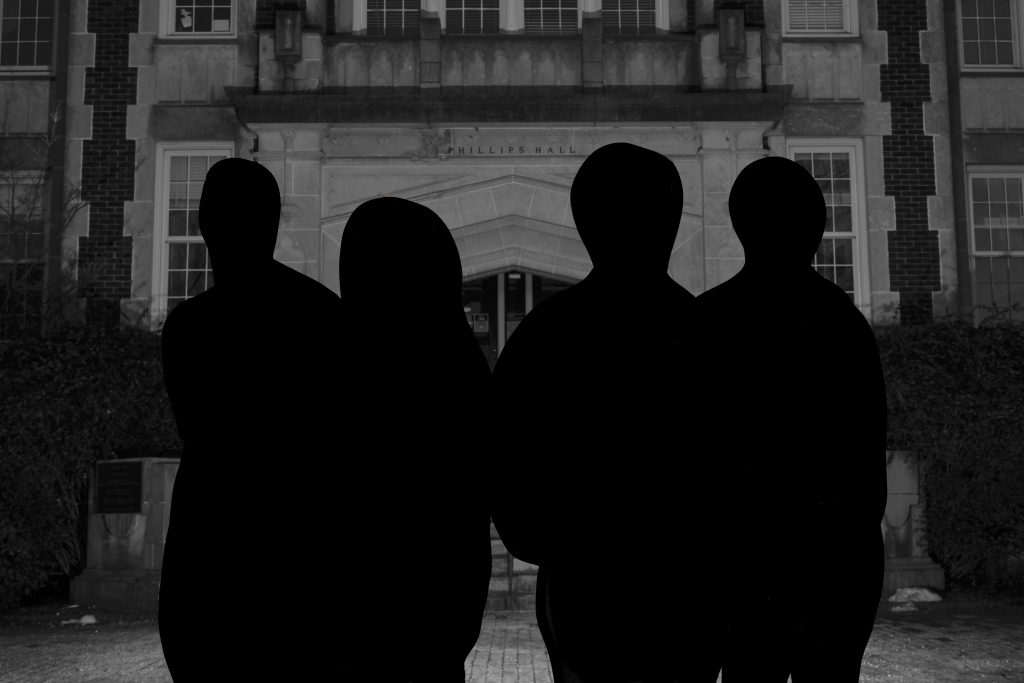The Missing Physicists
Event details
Presented by the Diversity Committee of the UNC Chapel Hill Physics & Astronomy Department, this special colloquium featured a panel discussion of the March 2022 “Missing Physicists” article package in Science, examining the barriers Black physicists face and potential models for change. See article links and synopses at the bottom of this page.
Date: Friday, April 8, 2022
Recording: Video and Chat/Q&A (including post-event panelist responses to Q&A)
Panelists
This event was planned by the UNC-CH Physics & Astronomy Diversity Committee. We especially thank Staff Diversity Liaison Shane Brogan, Undergraduate Diversity Liaisons Halona Dantes and Melissa Kissling, Graduate Student Diversity Liaison Xavier James, and communications specialist Tiffany Woodall for their superb work on event logistics.
The “Missing Physicists” Articles (Science, March 4, 2022)
Below are links and synopses of the articles for this event, all by Jeffrey Mervis; the full package is here.
Acronyms: HBCU = historically black college or university; PWI = primarily white institution; URM = underrepresented racial minority (in US: Black/African American, Hispanic/Latinx, Native American/Hawaiian); TEAM-UP = Task Force to Elevate African American Representation in Undergraduate Physics and Astronomy
1 | Can U.S. Physics Overcome Its Record of Exclusion?
Undergraduate physics degrees awarded to Black students dropped from ~5% to ~3% between 1999 and 2020, with absolute numbers staying flat as total physics degrees (incl. degrees for Hispanic students) roughly tripled. Top 10 producers of Black physics majors are HBCUs. In same 20 years, 30% of universities graduated 0 Black physics majors, another 30% 1-2. Double barrier for Black women: total of 150 U.S. physics PhDs ever awarded. Battling “uneven playing field” as well as a “culture that continues to question their ability” and “expects Black people to lead the way” in solving the problem.
2 | The Toll of White Privilege
Every one of 50 Black scientists interviewed experienced racism. White males are >2/3 of faculty in PhD granting physics departments and often express skepticism that racism or sexism are prevalent. Also believe they are in no position to undo the harm of such biases. Black tax = assumption that Black faculty will/should do more than whites to promote diversity via extra mentoring, committee service, outreach. Reliance on isolated champions unsustainable without institutional support. With one Black physicist, Stanford led U.S. in Black PhDs from 1970s-2000, but no carryover since his death. Physics’ condescension toward social science hinders learning to address sociological/institutional issues.
3 | Fix the System, Not the Students¹ (names of featured UNC programs in blue)
Rather than helping Black students, physics instructors assume they’re not good enough (“deficit model”) – see selves as gatekeepers. Black students choose more welcoming STEM fields. Need to nurture “physics identity.” Internships help but don’t level the playing field: UNC-CH’s computational astronomy & physics (CAP) boot camp is an alternative model. New URM grad-to-undergrad (G2U) mentoring based on AIP TEAM-UP report may help. Need to pay student mentors/leaders (DEI Scholars). Such initiatives are funded from insecure sources and are rare across the U.S. For enhancing graduate student representation, Fisk-Vanderbilt Bridge program is very successful, now a model for APS Bridge program, but not all HBCU-PWI partnerships succeed – must address stigma and climate issues.
4 | Black Colleges Can’t Do It All
HBCUs offer nurturing environment, albeit Black faculty often still in minority in science. Still dependent on sole champions who leave/burn out if unsupported. Heavy teaching loads. Shaky finances for scholarships and internships; federal funding favors one-off education experiments. Research funding minimal. PWI partnerships needed but must truly involve HBCU faculty.
5 | Michigan’s Surprising Path to Diversity
UM Applied Physics grad program created in 1987 as collaborative and very interdisciplinary; attracted URMs and women. Holistic admissions criteria. Attitude of helping students thrive rather than weeding them out. Association with traditional physics department exposed some students to toxic gatekeeping. Key mediating role of Black program staff in persuading faculty not to give up on students, students not to give up on program – often successful. By 2017 yielded 10% of all U.S. Black physics PhDs. Broadly extended as leadership changed, added Bridge option that funds URMs in 2-yr MA to prepare for PhD.
¹In the first version of article #3, Science indicated Zack Hall was on track to become the first Black PhD in physics from UNC Chapel Hill. This was incorrect. Despite incomplete records, we know of at least three previous cases:
-
Alexander Gardner (1963)
-
Floyd James (1983)
-
Phillip Williams (2002)
If you know of more missing from the list, please contact the department’s Associate Chair for Diversity and Mentoring. We also note that several Black PhD candidates are in the pipeline, including Derrick Carr, in the same year as Zack Hall and featured in a photo in article #3 (see our preferred caption for that photo here).



![Headshot of Mohammad Ahmed [he/him] .](https://physics.unc.edu/wp-content/uploads/sites/218/2022/03/Picture1-150x150.jpg)
![Headshot of Roy Clarke [he/him].](https://physics.unc.edu/wp-content/uploads/sites/218/2022/03/Picture2.jpg)
![Headshot of Zack Hall [he/him].](https://physics.unc.edu/wp-content/uploads/sites/218/2022/03/Picture3-150x150.jpg)
![Headshot of Sheila Kannappan [she/her].](https://physics.unc.edu/wp-content/uploads/sites/218/2022/03/Picture4.jpg)
![Headshot of Kent Wallace [he/him].](https://physics.unc.edu/wp-content/uploads/sites/218/2022/03/Picture5-150x150.jpg)
![Headshot of Jennifer Weinberg-Wolf [she/her].](https://physics.unc.edu/wp-content/uploads/sites/218/2022/03/Picture6-150x150.jpg)
![Headshot of Akaa Daniel Ayangeakaa [he/him].](https://physics.unc.edu/wp-content/uploads/sites/218/2022/03/Picture7-150x150.png)